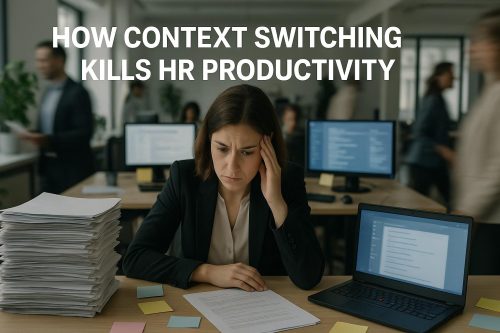DIY tools are reshaping HR by automating routine tasks and empowering employees to take control of processes like payroll, leave requests, and onboarding. These tools save time, reduce errors, and allow HR teams to focus on more impactful projects like talent development and employee engagement. Key insights include:
- Automation Potential: AI can handle 60-70% of routine tasks, freeing up HR resources.
- Employee Self-Service (ESS): 73% of U.S. workers value the autonomy ESS tools provide.
- AI in Hiring: Tools like Evie.ai cut hiring time by 30% and improve candidate experiences.
- Post-Pandemic Shift: 77% of employees see workplace culture as permanently changed, making digital tools essential.
Quick Overview of Benefits:
- Time Savings: Up to 64% reduction in candidate screening time.
- Efficiency Gains: 35% faster task completion with low-code tools.
- Employee Growth: Tools like Peoplebox.ai improve retention by 44%.
- Data Accuracy: Fewer payroll errors and better compliance.
These tools are transforming HR, but human oversight remains critical to ensure accuracy and maintain a people-first approach.
How DIY Tools Support Modern Workforces
Improving Employee Productivity Through Self-Service
DIY tools give employees the ability to handle work-related tasks on their own, with 73% of U.S. workers expressing interest in using DIY HR tools. Employee Self-Service (ESS) platforms let employees update personal details, view pay stubs, and request time off – saving time and cutting out unnecessary delays.
“For employees, it means control – no waiting on HR for pay slips, leave requests or personal data updates. For HR teams, it clears up a huge amount of time that would otherwise be spent handling basic admin.”
– Roksolana Stupen, HR Manager at IT Monks
These tools not only give employees more control but also allow HR teams to focus on more strategic priorities.
Shifting HR Focus to High-Impact Projects
No-code tools help HR departments shift their focus to areas that make a bigger difference:
| Strategic Focus Areas | Impact on Organization |
|---|---|
| Employee Development | Tailored training programs |
| Culture Building | Better engagement and morale |
| Talent Strategy | Smarter hiring and retention plans |
| Change Management | Smoother transitions during organizational shifts |
“Anything that can be accomplished on demand these days is an asset, as we all struggle to align flexible schedules, different time zones and more. It’s even better if employees do not need to wait for someone in the office to solve their pressing issue.”
– Stephen Kohler, Founder and CEO of Audira Labs
This shift in focus helps HR teams deliver greater value to the organization.
Main Benefits of Employee Self-Service Tools
Improved employee autonomy can significantly increase EBITDA on average.
“[ESS] ensures we are efficient as HR. We can see how much time a given problem takes, [and] we can calculate how many people in each function of HR we need to cater to employees’ needs. Collecting post-inquiry feedback reinforces HR’s commitment to continuous improvement.”
– Pavel Bahu, Global HR Head at Trevolution Group
Some of the key benefits of ESS systems include:
- Better Data Accuracy: When employees input their own data, payroll errors decrease, reducing compliance risks.
- Anytime Access: Employees can handle tasks and access information around the clock, supporting a healthier work-life balance.
- Simplified Processes: ESS tools integrate with existing systems, making it easier to manage tasks like performance reviews, training, benefits enrollment, and scheduling.
With 77% of employees believing workplace culture has permanently shifted post-pandemic, digital self-service tools have become a cornerstone of modern workplaces. These benefits pave the way for understanding how DIY tools are revolutionizing HR teams.
Key DIY Tools for Modern HR Teams
AI Tools for Hiring and Recruitment
Modern HR teams are turning to AI tools to streamline hiring processes and save time. A great example is Siemens Mobility, which implemented Evie.ai and saw a 30% reduction in time spent on talent acquisition tasks, along with 50% fewer interview reschedules and interviews scheduled 10x faster.
“Evie is so simple to use, saves 30% of my time and delivers a great candidate experience, allowing me to hire faster & better!”
- Marta Brockwell, Talent Acquisition Consultant, Siemens Mobility
What makes AI recruitment tools so effective? Here are some standout features:
| Feature | Impact |
|---|---|
| Automated Screening | Speeds up the initial review of candidates. |
| Interview Scheduling | Cuts down on email exchanges and simplifies scheduling. |
| Candidate Communication | Keeps candidates engaged throughout the hiring process. |
| Skills Assessment | Provides an objective view of candidates’ abilities. |
These tools are transforming recruitment, but they’re just one piece of the HR puzzle. Self-service platforms are another game-changer for modern teams.
Employee Self-Service and Support Systems
Employee self-service (ESS) platforms are becoming a staple in HR operations. Adoption rates have skyrocketed from 15% in 2014 to a projected 85% by 2024, with 61% of employees preferring self-service for routine tasks. These systems not only empower employees but also lighten the administrative workload for HR teams.
Key features of ESS platforms include:
| Feature | Business Impact |
|---|---|
| Streamlined Onboarding | Simplifies HR tasks and ensures a smooth start for new employees. |
| Enhanced Communication | Improves collaboration and information flow between staff and HR. |
| Centralized Information | Lets employees find answers on their own, reducing HR inquiries. |
| Improved Time & Attendance | Reduces errors and makes payroll processes more efficient. |
By automating routine tasks, ESS platforms free up HR to focus on more strategic initiatives. But supporting employee growth requires even more specialized tools.
Tools for Employee Growth and Assessment
Continuous feedback systems are proving to be a game-changer for talent management. Companies using these models report a 39% increase in talent attraction and a 44% boost in retention.
“Performance management motivates employees by linking personal goals to company objectives.”
- Jesse Ajebon, Founder & CEO at People Street
Take Peoplebox.ai, for example. In early 2025, they introduced AI-driven tools to automate performance reviews, pinpoint skill gaps, and design actionable development plans.
Here’s what effective growth and assessment tools bring to the table:
| Component | Purpose |
|---|---|
| Goal Tracking | Aligns personal objectives with broader company goals. |
| Continuous Feedback | Promotes regular performance discussions and timely insights. |
| Skill Development | Encourages ongoing learning and professional growth. |
| Performance Analytics | Delivers data-driven insights for better decision-making. |
These tools don’t just help employees grow – they also drive organizational success. Companies using such solutions report higher engagement, with 69% of employees saying they work harder when their efforts are recognized through regular feedback. Together, these tools create a workplace environment where both employees and businesses thrive.
The Art of the Possible: Practical AI and Automation Use …
sbb-itb-eb32bf3
Using Davavo‘s AI Agents in HR

Davavo’s AI agents build on the advantages of self-service and AI tools to simplify HR operations even further.
What Davavo’s HR AI Assistants Can Do
These AI agents handle complex HR tasks efficiently while ensuring compliance with regulations. They manage key processes like leave requests, payroll, retirement planning, and benefits coordination.
Here’s a breakdown of their main functions:
| Function | Business Impact |
|---|---|
| Leave Management | Processes requests automatically and ensures compliance tracking |
| Payroll Processing | Ensures accurate, timely payments and proper tax calculations |
| Benefits Administration | Simplifies enrollment and updates across systems |
| Compliance Reporting | Provides real-time tracking of regulatory adherence |
| Employee Onboarding | Speeds up new hire integration and documentation |
These tools work smoothly with your existing systems, making implementation straightforward.
Connecting Davavo with Your HR Software
Integrating Davavo’s AI agents with your current HR tools is simple and requires minimal technical setup. These agents enhance your workflows with features like:
| Feature | Advantage |
|---|---|
| Simplified Setup | Offers no-code integration and customizable workflows |
| Real-Time Sync | Keeps data consistent across platforms |
| Secure Data Transfer | Ensures strong security and privacy protections |
Human Oversight in AI Processes
Even with advanced automation, human involvement remains critical. Erik Brynjolfsson, a professor and senior fellow at the Stanford Institute for Human-Centered AI, highlights this:
“I would not advise turning it on and walking away. These systems have too many flaws. They don’t understand truth very well and kind of hallucinate facts. Right now it’d be downright dangerous to use AI tools without a human in the loop.”
Davavo includes oversight mechanisms to maintain accuracy and reliability:
| Oversight Element | Purpose |
|---|---|
| Review Checkpoints | Validate AI-generated decisions |
| Manual Override | Allow human intervention when necessary |
| Audit Trails | Record all automated actions and changes |
| Performance Monitoring | Track accuracy and overall effectiveness |
Companies that integrate AI with proper human oversight report better accuracy and dependability in HR processes. Brynjolfsson also notes:
“Keeping humans in the loop is the main focus. We must address to what extent do we keep humans in the loop rather than focus on driving down wages.”
This approach aligns with the European Union’s AI Act, which emphasizes the importance of human oversight in high-risk AI systems.
Building Your DIY HR System
Finding Gaps in Current HR Systems
Compare your current HR processes with your organization’s goals using this framework:
| Assessment Area | Key Questions to Ask |
|---|---|
| Process Efficiency | Are manual tasks slowing down HR operations? |
| Employee Experience | Where do employees encounter the most challenges? |
| Data Management | How well are we managing HR data? |
| Compliance | Are we meeting all regulatory requirements? |
Ed Gordon, author of Future Jobs: Solving the Employment and Skills Crisis, highlights a critical point:
“You can have all the latest technology you want, but if you don’t have the talent behind it, your business is not sustainable.”
These evaluations provide a strong foundation for building your system step by step.
Step-by-Step Implementation Guide
Use these steps to build your DIY HR system:
| Implementation Phase | Key Activities |
|---|---|
| Planning | Define objectives and map out current processes |
| Technical Review | Check compatibility with existing systems |
| Integration Setup | Configure APIs and test connections |
| Security | Put data protection measures in place |
Here are the key steps to focus on:
1. Define Clear Objectives
Start by analyzing your current operations and aligning them with your long-term goals.
2. Technical Assessment
Evaluate how well the new tools will integrate with your existing systems.
3. Prioritize Integration Points
Focus on the most impactful integrations. For example, connecting applicant tracking systems like Greenhouse to your HRIS ensures candidate data syncs automatically, reducing manual data entry.
After completing these steps, keep monitoring and refining your system to maintain its effectiveness.
Tracking Results and Making Improvements
Measure the success of your DIY HR system with clear metrics and regular feedback. Use a performance dashboard to track:
| Metric Category | What to Measure |
|---|---|
| Time Savings | Hours saved on HR tasks |
| Error Reduction | Fewer data entry mistakes |
| User Adoption | Employee usage rates |
| ROI | Cost savings and efficiency gains |
Keep your system up to date by:
- Monitoring API updates and revising integrations when needed
- Documenting processes and maintaining thorough testing protocols
- Gathering regular feedback from HR staff and employees
- Adjusting workflows based on performance data
The key to success is ensuring your technology fits seamlessly with your team’s needs and processes.
Conclusion
The use of DIY HR tools is transforming how companies manage their workforce. According to recent data, 81% of HR managers are looking into AI solutions, with some companies reporting up to a 64% cut in screening time. This shows that these tools not only improve efficiency but also help strengthen workplace connections.
While automation offers clear benefits, it’s important to balance it with the people-focused side of HR. For instance, a Dutch insurance company automated 91% of eligible motor claims, cutting processing time by 46% and increasing customer satisfaction by 9%.
“Integrating AI into the heart of operations demands more than technology – it’s a redefinition of the very essence of HR.”
Automation can streamline processes, but human oversight is still essential. Organizations that succeed with DIY HR tools focus on three major areas:
| Success Factor | Key Consideration | Impact |
|---|---|---|
| Strategic Integration | Align AI tools with company goals | Improved efficiency |
| Data Security | Ensure strong privacy and compliance measures | Protection of sensitive data |
| Continuous Improvement | Regularly monitor and gather feedback | Better performance and adoption |
These steps highlight how DIY HR tools are reshaping how HR operates today.
“Even with the rise of technology, the essence of HR remains grounded in building human connections and nurturing empathy. As we bring AI into our processes, it’s crucial to keep championing the cause of human interaction, ensuring that empathy and compassion stay front and center.”
FAQs
How can DIY HR tools empower employees and improve workplace efficiency?
DIY HR tools empower employees by giving them greater control over their tasks, schedules, and personal information. This autonomy fosters higher job satisfaction, improved work-life balance, and a stronger sense of ownership in their roles. Employees can independently access resources, manage benefits, and make informed decisions without relying on constant managerial intervention.
These tools also streamline routine processes like time tracking, leave requests, and performance reviews, freeing up time for more strategic work. By enabling self-service capabilities, organizations can enhance productivity, reduce administrative bottlenecks, and promote a culture of innovation and accountability. When employees feel empowered, they are more engaged and motivated, which directly contributes to overall workplace efficiency.
What challenges can arise from using AI in HR, and how can companies address them effectively?
Relying too heavily on AI in HR processes can lead to challenges such as employee distrust, operational inefficiencies, and increased workloads. Employees may feel uncertain about AI’s role in decision-making, especially if there’s a lack of transparency or proper communication. Additionally, rushed implementation without adequate training can result in frustration and reduced job satisfaction.
To address these risks, companies should focus on gradual AI rollouts, provide comprehensive training for employees, and ensure leadership involvement throughout the process. Clear communication about the purpose and benefits of AI tools can help build trust, while ongoing human oversight ensures AI outputs align with organizational standards and values. By taking these steps, businesses can harness the benefits of AI while minimizing potential downsides.
How can companies integrate AI tools into HR while maintaining a people-first approach?
To integrate AI tools into HR while keeping a people-first approach, companies should focus on balancing technology with human-centric values. Use AI to automate repetitive tasks, allowing HR professionals to dedicate more time to strategic and employee-focused initiatives. Ensure transparency by establishing clear ethical guidelines for AI usage, prioritizing fairness and accountability to build trust.
Involve employees in the selection and implementation of AI tools to foster collaboration and provide training to help them understand and use the technology effectively. Additionally, leverage AI to personalize employee experiences, such as tailored learning programs and benefits, while using it to monitor well-being and proactively address concerns. By designing intuitive, user-friendly AI systems and continuously gathering feedback, companies can ensure these tools enhance the employee experience without losing the human touch.





